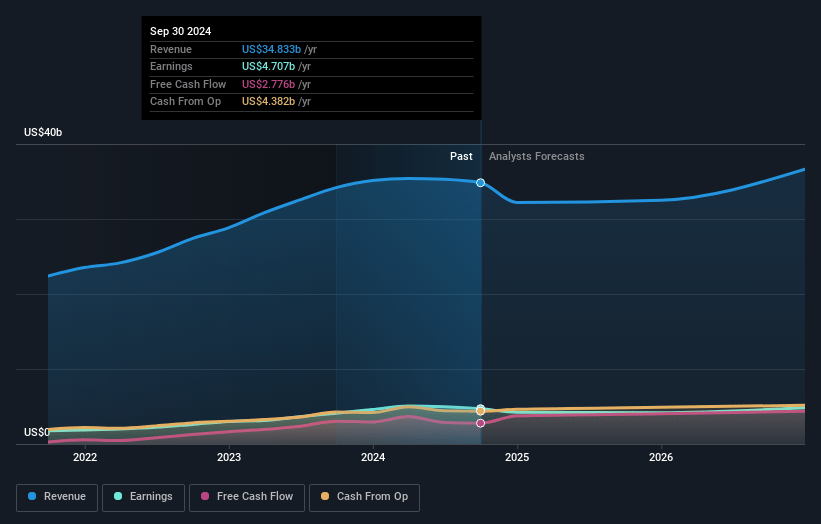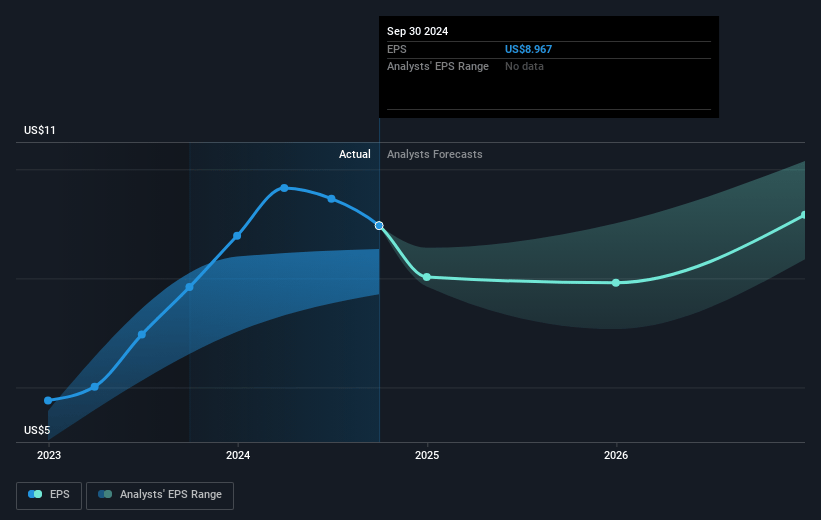Key Takeaways
- Anticipated declines in truck deliveries and a tough market environment could constrain PACCAR's revenue growth and top-line performance.
- Regulatory, currency challenges, and R&D expenses might pressure PACCAR's profit margins if investments in new technologies don't yield quick returns.
- PACCAR's strong market position and strategic investments in technology and facilities are expected to sustain revenue growth and enhance profitability across expanding global markets.
Catalysts
About PACCAR- Designs, manufactures, and distributes light, medium, and heavy-duty commercial trucks in the United States, Canada, Europe, Mexico, South America, Australia, and internationally.
- The projected truck delivery decline in the first quarter of 2025 suggests potential revenue contraction, as deliveries are forecasted to drop from 43,900 to around 40,000 units. This decrease could weigh on PACCAR’s top line performance.
- The U.S. and Canadian Class 8 truck market is expected to face a challenging environment, with projections of 250,000 to 280,000 vehicles in 2025, down from 268,000 units previously. If the lower end of forecasts materializes, it would imply weaker revenue growth than anticipated.
- Stagnant growth in the European truck market is anticipated, with registrations foreseen to be between 270,000 to 300,000 units in 2025, potentially stagnating revenues in a key region and affecting overall earnings.
- Currency fluctuations, especially a strong dollar, negatively impacted PACCAR's net income in the fourth quarter by roughly 20 million dollars. If these currency trends persist, they could further compress profit margins.
- Recent shifts in regulatory policies, such as those affecting battery electric vehicles (BEVs) and other emerging technologies, could pose challenges to PACCAR's costs of adaptation and R&D expenses, potentially narrowing net margins if the investments do not generate quick returns.
PACCAR Future Earnings and Revenue Growth
Assumptions
How have these above catalysts been quantified?- This narrative explores a more pessimistic perspective on PACCAR compared to the consensus, based on a Fair Value that aligns with the bearish cohort of analysts.
- The bearish analysts are assuming PACCAR's revenue will decrease by 8.0% annually over the next 3 years.
- The bearish analysts assume that profit margins will shrink from 12.4% today to 12.1% in 3 years time.
- The bearish analysts expect earnings to reach $3.2 billion (and earnings per share of $6.0) by about April 2028, down from $4.2 billion today. The analysts are largely in agreement about this estimate.
- In order for the above numbers to justify the price target of the more bearish analyst cohort, the company would need to trade at a PE ratio of 19.4x on those 2028 earnings, up from 11.2x today. This future PE is lower than the current PE for the US Machinery industry at 19.7x.
- Analysts expect the number of shares outstanding to grow by 0.13% per year for the next 3 years.
- To value all of this in today's terms, we will use a discount rate of 7.77%, as per the Simply Wall St company report.
PACCAR Future Earnings Per Share Growth
Risks
What could happen that would invalidate this narrative?- PACCAR's high profitability of the latest generation trucks along with the record results in their Parts division could sustain or grow their revenue and margins.
- The U.S. economy is projected to expand by more than 2% in 2025, which could support stronger demand for trucks, positively affecting PACCAR's earnings and revenue.
- PACCAR's strong market share growth to 30.7% in U.S. and Canadian Class 8 truck market and its 18% share in the medium-duty market positions it well to maintain or improve its revenue and profitability.
- PACCAR's strategic investments in new products, world-class facilities, and cutting-edge technologies over the past decade could enhance its operating efficiencies and net margins.
- With PACCAR's strong presence in geographical markets experiencing economic growth, such as Brazil, Europe, and others, its revenue and sales volumes may rise, supporting earnings growth.
Valuation
How have all the factors above been brought together to estimate a fair value?- The assumed bearish price target for PACCAR is $93.32, which represents one standard deviation below the consensus price target of $108.0. This valuation is based on what can be assumed as the expectations of PACCAR's future earnings growth, profit margins and other risk factors from analysts on the more bearish end of the spectrum.
- However, there is a degree of disagreement amongst analysts, with the most bullish reporting a price target of $134.0, and the most bearish reporting a price target of just $78.0.
- In order for you to agree with the bearish analysts, you'd need to believe that by 2028, revenues will be $26.2 billion, earnings will come to $3.2 billion, and it would be trading on a PE ratio of 19.4x, assuming you use a discount rate of 7.8%.
- Given the current share price of $88.77, the bearish analyst price target of $93.32 is 4.9% higher. The relatively low difference between the current share price and the analyst bearish price target indicates that the bearish analysts believe on average, the company is fairly priced.
- We always encourage you to reach your own conclusions though. So sense check these analyst numbers against your own assumptions and expectations based on your understanding of the business and what you believe is probable.
How well do narratives help inform your perspective?
Disclaimer
AnalystLowTarget is an employee of Simply Wall St, but has written this narrative in their capacity as an individual investor. AnalystLowTarget holds no position in NasdaqGS:PCAR. Simply Wall St has no position in the company(s) mentioned. Simply Wall St may provide the securities issuer or related entities with website advertising services for a fee, on an arm's length basis. These relationships have no impact on the way we conduct our business, the content we host, or how our content is served to users. This narrative is general in nature and explores scenarios and estimates created by the author. The narrative does not reflect the opinions of Simply Wall St, and the views expressed are the opinion of the author alone, acting on their own behalf. These scenarios are not indicative of the company's future performance and are exploratory in the ideas they cover. The fair value estimate's are estimations only, and does not constitute a recommendation to buy or sell any stock, and they do not take account of your objectives, or your financial situation. Note that the author's analysis may not factor in the latest price-sensitive company announcements or qualitative material.







